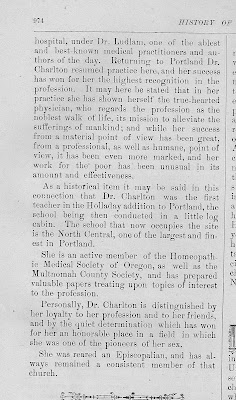H.K. Hines published An Illustrated History of the State of Oregon (Chicago: Lewis Publishing Company, 1893) when Esther Clayson was a student at the University of Oregon Medical Department in Portland. Like the Oregonian Souvenir, published the year before, this book provides some context for Portland and Oregon life and culture in this same period.
Hines, a Methodist minister and trustee of Willamette University published few biographical entries of women. But he did include Callie Brown Charlton, M.D., Esther Clayson's mentor in medicine.
She attended St. Mary's Academy in Portland and in 1872, widowed with a small daughter, Lorena, decided to study medicine. Charlton taught school in Portland's Holladay Addition and studied with Dr. C. H. Raffety (Willamette University Medical Department graduate of 1869) before being admitted to the Willamette University Medical Department, receiving her diploma in 1879.
Hine places Charlton at the center of female student activism at Willamette without, alas, giving us much detail. He notes that "it was only the second year that the sex had been admitted to the college [this was not accurate -- Hine was omitting Mary Sawtelle] while many discriminating restrictions were placed upon them, and the course of study to which they were admitted was much circumscribed, essential features being eliminated." These "essential features" likely included dissection.
"Against much opposition," Hine continued, "Mrs. Charlton led the contest for the rights of women, which proved successful, and by which she won the lasting esteem of the faculty and management, among whom are yet numbered some of her warmest friends; her genuine earnestness in the search of knowledge in the line of her chosen profession had much to do with this feeling, as well as with her success."
Willamette admitted women with restrictions after Mary Sawtelle's controversial time there. Materials at the Willamette University Archives suggest that many male faculty opposed women as students and for a time in the 1880s women were officially banned. We need to know more about this story and Charlton's role in challenging restrictions to women's medical education in Oregon.
Charlton embraced homeopathy, a popular therapeutics at the time
[see Anne
Taylor Kirschmann, A Vital Force: Women
in American Homeopathy (New Brunswick, NJ: Rutgers University Press, 2004)]. She studied for a second degree at Hahnemann Medical College in Chicago and graduated in 1886 (Hine's 1866 is a typo). She returned to practice in Portland and delivered Esther Clayson's sister Charlotte in 1884. Esther's mother Annie Clayson invited Charlton to dinner and Charlton became a role model for Esther and her medical ambitions.
Here is Charlton's entry in H.K. Hines An Illustrated History of the State of Oregon (Chicago: Lewis Publishing Company, 1893). The text appears on pages 973 and 974 and her image faces page 973.










